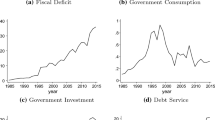Concluding remarks
The results of our tests indicate similarities between the expenditure-tax receipt relations of state governments to those previously reported for the Federal government in Manage and Marlow (1986); the results reported here indicate support for the hypothesis that tax receipts cause expenditures at the state level of government. For tests utilizing symmetric lag structures ranging from three to five years, state expenditures appear to follow state tax receipts. For the shortest lag length (2,2), the determination of bidirectional causality does not make us reject the hypothesis that higher spending levels result from higher revenue levels; rather, the causality appears to be in both directions for the shortest lag length.
The finding that tax revenues and expenditures are not causally related at the local level for the three longest lag structures is unexpected. However, the result may be a product of an aggregation problem. The fact that all local governments are aggregated on a state-by-state basis may generate observations that are not useful for our empirical work. For example, if the funding constraints of local governments on a state-by-state basis are especially diverse, their aggregation to the state level of observation may produce data that is not economically meaningful. Nonetheless, the one case where significant causality is observed lends some empirical support for the hypothesis that tax receipts determine spending.
Two policy implications are mentioned. One, policy proposals at all levels of governments aimed at solving the occurrence of unacceptably large deficits should consider the linkage between expenditures and tax receipts before they recommend discretionary changes in either or both of the components of deficits: expenditures and tax receipts. For example, the results of our tests do not rule out the notion that a tax increase could promote expenditures that ultimately counter the deficit-reducing effect of a given tax hike.
Two, the fact that our results at the state level lend support for the view that causality runs one-way from expenditures to tax receipts suggests that the many dissimilarities in legislative and constitutional constraints between the Federal and state levels of government may not matter much in terms of the causal relation between expenditures and tax revenues. A possible reason for similarities in behavior may stem from the circumvention of legislative or constitutional intent at the state level of government which ultimately serve to weaken differences between the effective constraints facing Federal and state governments. Moreover, it would be puzzling if we found widely disparate behaviors between government units in the absence of significantly different constraints.
Similar content being viewed by others
References
Bennett, J.T., and DiLorenzo, T.J. (1982). Off-budget activities of local governments: The bane of the tax revolt. Public Choice 39: 333–342.
Box, G.E. and Gwilym M. Jenkins, A.M. (1970). Time series analysis: Forecasting and control. San Francisco: Holden Day.
Brennan, G., and Buchanan, J.M. (1980). The power to tax: Analytical foundations of a fiscal constitution. Cambridge; New York: Cambridge University Press.
Brennan, G., and Buchanan, J.M. (1977). Towards a tax constitution for Leviathan. Journal of Public Economics 8 (December): 255–273.
Congressional Budget Office (1982). Balancing the Federal budget and limiting Federal spending; Constitutional and statutory approaches. Washington, DC.
Conway, R.K., Swamy, P.A.V.B., Yanagida, J.F. Von Zur Muehln, P. (1984). The impossibility of causality testing. Agricultural Economics Research (Summer): 1–19.
Granger, C.W. (1969). Investigating causal relations by econometric models and cross spectral methods. Econometrica (July): 424–438.
Manage, N. and Marlow, M.L. (1986). The causal relation between Federal expenditures and receipts. Southern Economic Journal 52 (January): 617–629.
Manage, N. and Marlow, M.L. (1985). Expenditures and receipts: Testing for causality in government finances. Presented at the 1985 meetings of the Southern Economic Association in Dallas, Texas.
Marlow, M.L. (1986). Private sector shrinkage and the growth of industrialized economies. Public Choice 49(2): 143–154.
Nelson, C.R., and Schwert, G.W. (1982). Tests for predictive relationships between time series variables: A Monte Carlo investigation. Journal of the American Statistical Association (March): 11–18.
Tax Foundation Inc. (1983). Facts and figures on government finance. Washington, DC.
Author information
Authors and Affiliations
Additional information
The views expressed are those of the authors alone and do not necessarily represent the views of the U.S. Department of Treasury.
Rights and permissions
About this article
Cite this article
Marlow, M.L., Manage, N. Expenditures and receipts: Testing for causality in state and local government finances. Public Choice 53, 243–255 (1987). https://doi.org/10.1007/BF00127349
Issue Date:
DOI: https://doi.org/10.1007/BF00127349




